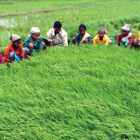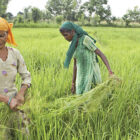The finance minister’s frequent reference to the “Amrit Kaal” — India’s 25-year-long lead-up to its first centenary of Independence in 2047 — in her budget speech, encompasses, in no small measure, its massive accomplishment of running the world’s largest welfare program: that of feeding 800 million of its populace through entitlements of free and subsidized food. As a farmer, one hopes that a better measure of accomplishment would certainly be India not having to feed anyone for free because everyone could afford nutritious meals.
Times have been harsh and, with the pandemic adding to the severity of the situation, there is anxiety everywhere that has engulfed the youth. Over a fourth of the youth in the country are without employment and that is even without factoring in the disguised unemployment across the villages. After last year’s globally the largest and longest farmer’s protest ratcheted up the pressure on the government, students are now agitating for jobs. The era of mass protests is just about beginning. The finance ministry may have lost its appetite for bold announcements, but the government overly influenced by foreign consultants & businesses remains resolute in falsely assuming a trickle-down economy will resolve the problem. Unemployment is and will remain the biggest challenge India faces. It is like a power-keg waiting to go off.
There is much more at stake though. In this vortex, one has inflation raising its head. The emerging picture is frightening. People will afford less nutrition food, poor households will see dwindling savings; medical treatment will be deferred; more food will be cooked by burning wood; and, for all purposes, education degrees will lose relevance. That will be India adjusting to the new normal. As the illusion of PMKISAN is unravelling in the villages; the monthly dole of ₹ 500, limited to the landowning classes does not even cover the rise in gas cylinder prices, two-wheeler fuel cost, tractor diesel price hike or health care and education costs that have shot up multiple times. In all probability, in the budget 2023, a year before the parliamentary elections, the government will double the amount to ₹ 1,000. At the least the FM did not fall for election populism this year. Arguably, the backlog of problems received by Nirmala Sitharaman left her with little room to manoeuver. The rising global fuel and fertilizer prices have forced tougher choices upon the nation.
The allocation for Ministry of Fisheries, Animal Husbandry and Dairying is up substantially as is for Rashtriya Krishi Vikas Yojana. One can only hope the talk of millets and oilseeds will be backed by real resources unlike the allocations for natural farming. But there are many instances of reduction and stagnancy in budgetary allocations of departments like rural development and health. Programs guaranteeing rural employment have been slashed too. Even when there is an increase in allocation of programs like agriculture research and education, it does not even offset the level of inflation. After 6 years of rhetoric, doubling farmer income slogan is expectedly and conveniently forgotten. This budget will be remembered for its eerie silence on making a difference to Indian agriculture. While international inflationary concerns are flagged as a problem in the economic survey, but that is also why agriculture registers a growth with improved international commodity prices. Farmers have responded to higher prices with higher agriculture productivity. Even so, the FM tripped in not declaring a statutory imposition of import duties on crops where landing cost is below the MSP (where declared) or below remunerative prices (where there is no MSP) so that these do not enter Indian markets below a threshold price.
Across India, union government and the states are highly indebted with a large portion of revenue receipts being used for interest payments. In-spite of this fact; there is a desperate rush for creating new physical infrastructure rather than prioritizing human resources, by filling vacancies in all critical departments from policing, health, farm extension, animal husbandry, education, revenue and administrative etc. This is playing havoc with India’s future and simply amounts to transferring the costs, including cost of missed opportunities to future generations. The government refuses to confront the reality that social welfare schemes also need to be sustainable. It’s also wasted the occasion by not committing for re-purposing of farm subsidies to payment for farm ecosystem services. Hope for a shift of MSP procurement to crops other than wheat and paddy has been belied. Overall, one senses the absence of systems approach or even a long-term vision. Clearly in agriculture like in other departments, each department is solving a piece of the problem in isolation. It is not as if India’s growth story is jinxed; it just that policy-makers routinely mistake a plan for a strategy and refuse to even acknowledge the difference.




